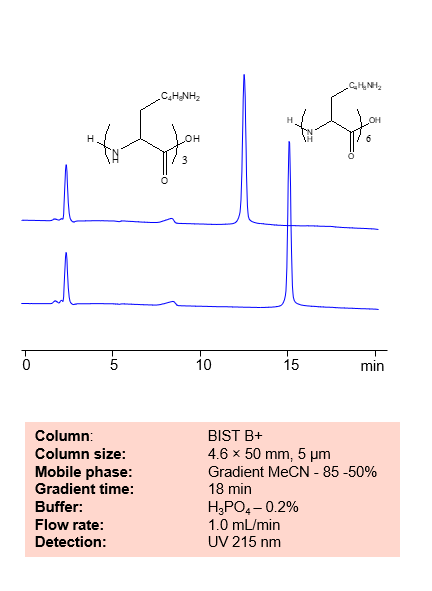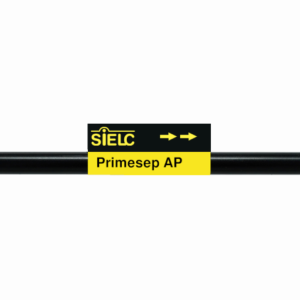Applications:
HPLC Method for Analysis of Polylysine on BIST™ B+ Column
November 30, 2022
HPLC Method for Analysis of Polylysine on BIST B+ by SIELC Technologies.
Separation type: Bridge Ion Separation Technology, or BIST™ by SIELC Technologies
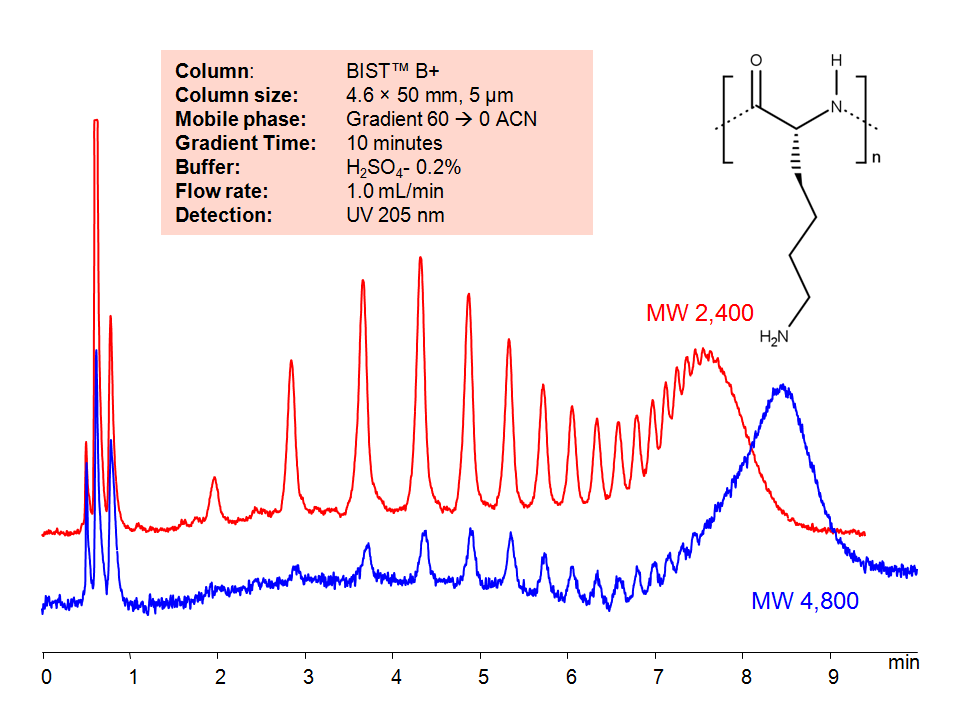
High Performance Liquid Chromatography (HPLC) Method for Analyses of Polylysine
Polylysine includes a large group of similar polymers with various uses. Some are used as food preservatives, while others are used for drug delivery in pharmaceuticals. Polymers with charged monomeric units, such as polylysine, are often difficult to separate using typical ion-exchange chromatography due to very strong and often irreversible interactions with the oppositely charged column surface. Therefore, an extremely high concentration of the buffer, up to several molar, is usually needed to facilitate an ion-exchange process. This high buffer concentration, however, is not desirable because of the significantly increased viscosity of the mobile phase and the salt formation in the pump components. With BIST™, these polymers can be separated and retained with relatively weak buffers (in the mM regime) and a fairly simple gradient. Using this new and unique analysis method, polylysine can be retained and UV detected at 205 nm.
Condition
| Column | BIST B+, 4.6×50 mm, 5 µm, 100A |
| Mobile Phase | Gradient MeCN |
| Buffer | H2SO4 – 0.2% |
| Flow Rate | 1.0 ml/min |
| Detection | UV 205 nm |
| Peak Retention Time |
Description
| Class of Compounds | Peptide, Homopolypeptide |
| Analyzing Compounds | Polylysine |
Application Column
BIST B+
BIST™ columns offer a unique and effective way to achieve separations that were traditionally challenging or even impossible with other HPLC columns. With the use of a special mobile phase, these ion exchange columns provide very strong retention for analytes with the same charge polarity as the stationary phase, unlocking new chromatography applications. What makes BIST™ columns stand out is their proprietary surface chemistry, which results in superior selectivity, resolution, and sensitivity. These columns offer a simple, efficient solution for a variety of analytical challenges, making them an excellent choice for researchers and analysts across many different fields. To learn more about the technology that powers BIST™ columns and to explore related applications, check out https://BIST.LC.
Select options
HPLC Method for Analysis of Low MW Polylysine on BIST™ B+ Column
November 30, 2022
HPLC Method for Analysis of Low MW Polylysine on BIST B+ by SIELC Technologies.
Separation type: Bridge Ion Separation Technology, or BIST™ by SIELC Technologies

High Performance Liquid Chromatography (HPLC) Method for Analyses of Low MW Polylysine
Polylysine includes a large group of similar polymers with various uses. Some are used as food preservatives, while others are used for drug delivery in pharmaceuticals. Polymers with charged monomeric units, such as polylysine, are often difficult to separate using typical ion-exchange chromatography due to very strong and often irreversible interactions with the oppositely charged column surface. Therefore, an extremely high concentration of the buffer, up to several molar, is usually needed to facilitate an ion-exchange process. This high buffer concentration, however, is not desirable because of the significantly increased viscosity of the mobile phase and the salt formation in the pump components. With BIST™, these polymers can be separated and retained with relatively weak buffers (in the mM regime) and a fairly simple gradient. Using this new and unique analysis method, polylysine can be retained and UV detected at 205 nm.
Condition
| Column | BIST B+, 4.6×50 mm, 5 µm, 100A |
| Mobile Phase | Gradient MeCN |
| Buffer | H2SO4 – 0.2% |
| Flow Rate | 1.0 ml/min |
| Detection | UV 205 nm |
| Peak Retention Time |
Description
| Class of Compounds | Peptide, Homopolypeptide |
| Analyzing Compounds | Polylysine |
Application Column
BIST B+
BIST™ columns offer a unique and effective way to achieve separations that were traditionally challenging or even impossible with other HPLC columns. With the use of a special mobile phase, these ion exchange columns provide very strong retention for analytes with the same charge polarity as the stationary phase, unlocking new chromatography applications. What makes BIST™ columns stand out is their proprietary surface chemistry, which results in superior selectivity, resolution, and sensitivity. These columns offer a simple, efficient solution for a variety of analytical challenges, making them an excellent choice for researchers and analysts across many different fields. To learn more about the technology that powers BIST™ columns and to explore related applications, check out https://BIST.LC.
Select options
HPLC Method for Analysis of Narrow Fractions of Polylysine on BIST B+ Column
November 30, 2022
HPLC Method for Analysis of Narrow Fractions of Polylysine on BIST B+ by SIELC Technologies.
Separation type: Bridge Ion Separation Technology, or BIST™ by SIELC Technologies
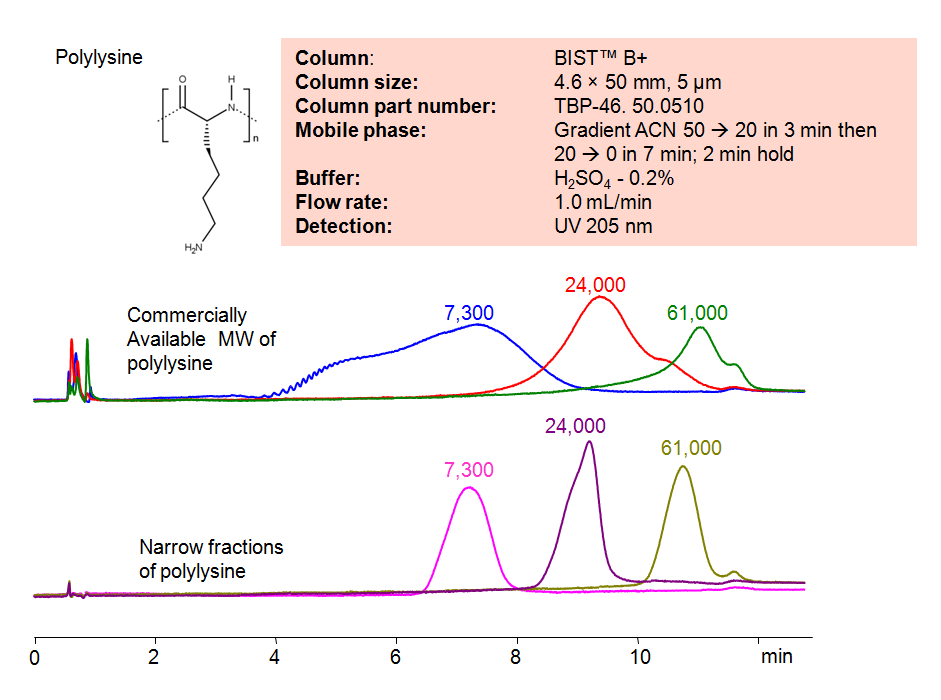
High Performance Liquid Chromatography (HPLC) Method for Analyses of Narrow Fractions of Polylysine
Polylysine includes a large group of similar polymers with various uses. Some are used as food preservatives, while others are used for drug delivery in pharmaceuticals. Polymers with charged monomeric units, such as polylysine, are often difficult to separate using typical ion-exchange chromatography due to very strong and often irreversible interactions with the oppositely charged column surface. Therefore, an extremely high concentration of the buffer, up to several molar, is usually needed to facilitate an ion-exchange process. This high buffer concentration, however, is not desirable because of the significantly increased viscosity of the mobile phase and the salt formation in the pump components. With BIST™, these polymers can be separated and retained with relatively weak buffers (in the mM regime) and a fairly simple gradient. Using this new and unique analysis method, polylysine can be retained and UV detected at 210 nm.
Condition
| Column | BIST B+, 4.6×50 mm, 5 µm, 100A |
| Mobile Phase | Gradient MeCN |
| Buffer | H2SO4 – 0.2% |
| Flow Rate | 1.0 ml/min |
| Detection | UV 205 nm |
| Peak Retention Time | 2.9 min |
Description
| Class of Compounds | Peptide, Homopolypeptide |
| Analyzing Compounds | Polylysine |
Application Column
BIST B+
BIST™ columns offer a unique and effective way to achieve separations that were traditionally challenging or even impossible with other HPLC columns. With the use of a special mobile phase, these ion exchange columns provide very strong retention for analytes with the same charge polarity as the stationary phase, unlocking new chromatography applications. What makes BIST™ columns stand out is their proprietary surface chemistry, which results in superior selectivity, resolution, and sensitivity. These columns offer a simple, efficient solution for a variety of analytical challenges, making them an excellent choice for researchers and analysts across many different fields. To learn more about the technology that powers BIST™ columns and to explore related applications, check out https://BIST.LC.
Select options
Separation of Small Lysine-based Peptide Oligomers on BIST B+ Column
July 8, 2011
Polylysine includes a large group of similar polymers with various uses. Some are used as food preservatives, while others are used for drug delivery in pharmaceuticals. Polymers with charged monomeric units, such as polylysine, are often difficult to separate using typical ion-exchange chromatography due to very strong and often irreversible interactions with the oppositely charged column surface. Therefore, an extremely high concentration of the buffer, up to several molar, is usually needed to facilitate an ion-exchange process. This high buffer concentration, however, is not desirable because of the significantly increased viscosity of the mobile phase and the salt formation in the pump components. With BIST™, these polymers can be separated and retained with relatively weak buffers (in the mM regime) and a fairly simple gradient. Using this new and unique analysis method, polylysine can be retained and UV detected at 215 nm.
| Column | BIST B+, 4.6×150 mm, 5 µm, 100A |
| Mobile Phase | MeCN/H2O |
| Buffer | H3PO4 |
| Flow Rate | 1.0 ml/min |
| Detection | UV 215 nm |
| Class of Compounds |
Drug, Acid, Hydrophilic, Ionizable, Vitamin, Supplements |
| Analyzing Compounds | Lysine-based Peptide Oligomers |
Application Column
Polylysine
UV Detection

HPLC Analysis of Polylysine on Primesep AP Column
October 14, 2010
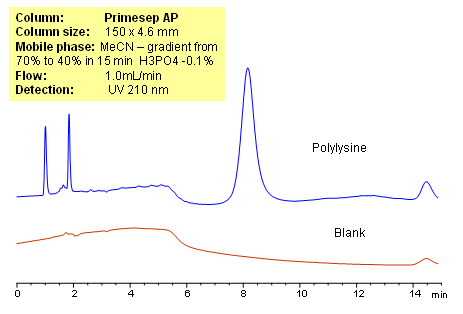
Polylysine is a small natural homo-polymer made out of amino acid lysine that is produced by bacterial fermentation. Due to the fact that it is a complex mixture of polymers with different molecular weight it is very hard to obtain a single sharp peak for this compound. Polylysine was successfully analyzed on a Primesep AP column in HILIC/cation-exclusion mode. Cation-exclusion mode on a Primesep AP column allows to obtain sharper peak. Presence of the basic groups on the surface of silica eliminated silanol interactions between basic sites of polylysine and acidic sites of Primesep AP column.
Application Column
Primesep AP
The Primesep family of mixed-mode columns offers a wide variety of stationary phases, boasting unprecedented selectivity in the separation of a broad array of chemical compounds across multiple applications. Corresponding Primesep guard columns, available with all stationary phases, do not require holders. SIELC provides a method development service available to all customers. Inquire about our specially-tailored custom LC-phases for specific separations.
Select options


